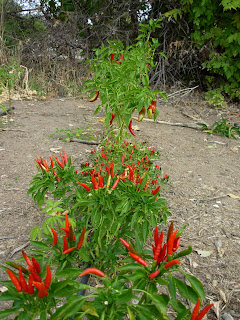
Another extremely effective way to procrastinate and put off any diss writing is to plant a garden. If done correctly this can actually require an almost year-round effort. In february the seed catalogs start to arrive and much careful reading and planning are required in order to buy the seeds of a variety of plants that are best suited for your region. This must be done in light of the performance of the previous season's garden, which of course takes time. After you have determined what to plant the coming year, you have to order any seeds so that you have them in time to start any long-season growers indoors (since i live in utah most of the tomatos and chiles i grow have to be started indoors).
In march and april you then have to start your seeds inside. It takes a good amount of time to plant and label all the seeds. you then must daily check to ensure that the seeds have enough moisture and are at the appropriate tempurature.
Once the seeds have germinated and the seedlings have their second set of leaves it is time to transplant. This is again a labor-intensive and ongoing process. Since some seedlings germinate and grow rather quickly, and a few species of peppers can take as long as 2 months to germinate, the process of replanting is ongoing from march through may.
In may, once it starts to warm up the seedlings have to be hardened off. Since they have grown under flourescent lights they would quickly shrivel and die under the stronger ultraviolet rays of the sun and the drying wind so it is necessary to gradually acclimate the seedlings to sunlight and wind. i start with about an hour a day in filtered sunlight, then gradually build up more and more time and more and more direct sunlight each day until around mid-may when they have hardened up to handdle the sun and wind. This process requires taking all the plants out and then bringing them back in each day until they are ready.
Once the plants are hardened off and the night temps are consistently above 50 degrees, its time to plant. Before i can plant, however, i have to prepare the garden which requires tilling, picking up and spreading compost or horse manure, checking all the water lines, and fixing any broken pipes or water emmitters. Then the plantinng begins. In each whole i put some compost from my composter, the plant, then water liberally with "superthrive" which helps the transplant shock.

For the remainder of the year i have to constantly hoe and weed. This year i slacked a bit when i went to hawaii and now i'm paying the price because i can't even find some of my chiles or eggplants. the tomatillos, sunflowers, and weeds have taken over parts of the garden.


Then starting around mid july until the first hard frost of october it's time to harvest. These are the delights of home gardening that make it all worth it: aunt ruby's green tomatos, annaheim chiles, thai hot chiles, cayenne chiles, etc. etc.
Now i start searching for recipes to start cooking. July through november i can be cooking with everything from thai eggplants, tomatos, chiles, butternut, pumpkins, cucumbers, zuchini, raspberries, blackberries, spinach, and on and on.
if i have a good crop i will also need to can and dry a lot of what i've grown. this is also quite a time-consuming process that is well worth the rewards. Habanero pepers year round are well worth the effort.
If done right gardening can consume a significant amount of time from february all the way through october or november. i recommend it for anyone looking for ways to avoid writing.



No comments:
Post a Comment